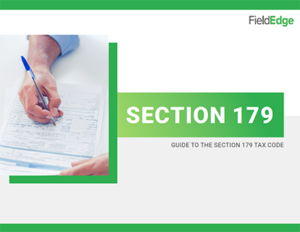Tax Season is Coming!
Everyone loves a good discount. In preparation for the upcoming tax season, we’re sure everyone is looking to save some money and get great deductions.
Luckily for small-medium businesses (SMBs) in the service industry, you can save hundreds of thousands of dollars thanks to Section 179 of the IRS tax code. Curious? We knew you would be.
Section 179: What Is It?
What is Section 179?
Section 179 allows SMBs to deduct the full price of qualifying equipment and/or software purchased and put into service during the 2018 tax year. For 2018, the spending cap on equipment purchases is $2,500,000, the deduction limit is up to $1,000,000 and bonus depreciation is 100%. In order to qualify, there are two requirements that must be fulfilled:
- Deduction is good for new or used equipment and off-shelf software (A full list of qualifying equipment can be found here).
- Equipment and software must be financed/purchased and put into service between January 1, 2018 to December 31, 2018.
Who Does Section 179 Benefit?
Section 179 is especially beneficial to SMBs. It encourages SMBs to buy equipment and invest in themselves. So rather than worrying about costs, you can think about how your business can grow.
There is a special IRS tax form for the Section 179 deduction and it can be found here along with instructions. The form must be filled out and submitted by midnight of December 31, 2018 to be eligible for the deduction.
Off-Shelf Software
What is Off-Shelf Software?
One of the requirements specifically mentions off-shelf software. You may be wondering what off-shelf software is. Simply put, off-shelf software is computer software that is:
- Not custom designed
- Available to the general public
Field service management software like FieldEdge falls under the category of off-shelf software. Therefore, businesses that purchase or purchased FieldEdge in 2018 can take advantage of the tax deduction.
Section 179 Limitations
There are two limitations to keep in mind when it comes to Section 179.
Business Income Limitation
The business income limitation is pretty straightforward. A business can’t deduct more than the business’s net taxable income from a trade or business. Instead, the costs that aren’t deducted during that specific tax year can be carried over to the next tax year.
For example, let’s say that your business’s net taxable income is $500,000. You end up purchasing and putting into service $515,000 worth of equipment in 2018. Your business’s maximum deduction for the 2018 tax season is $500,000. The remaining $15,000 can be deducted the next tax year in 2019.
Spending Cap Limitation
As we mentioned before, the 2018 spending cap is $2,500,000. If your business spends beyond the $2.5 million cap, the deduction will start to phase out on a dollar-by-dollar basis. So, if your business ends up spending $3.5 million, the deduction will go away completely.
To help explain the limitations of Section 179, we enlisted the help of Mike Slack, Lead Tax Research Analyst at The Tax Institute at H&R Block. According to Slack,
“The Section 179 deduction has two limiting factors: a business income limitation and a phaseout on the maximum allowable deduction.
The business income limitation provides that your maximum deduction cannot exceed your income derived from a trade or business. Any amount Section 179 expensing amount you claim in excess of your business income becomes a carryover to offset business income in future years.
While the general maximum Section 179 deduction is $1 million, the second limitation begins to lower your maximum deduction dollar-for-dollar once your expenditures for a given year exceed $2.5 million, with the deduction becoming completely unavailable once expenditures reach $3.5 million. For example, if you have $2.75 million dollars in qualifying expenditures for the year, the maximum amount maximum amount of §179 that you can take is $750,000.”
The reason for these limitations is to maintain the tax deduction exclusively for SMBs.
Ask for Help
Since we only have a couple months left until the deadline, it’s important to reach out to a tax accountant and see if your business is eligible for the deduction. Once you talk to a tax accountant, you can better understand how it can apply to your business. We promise that it will be well worth the effort and you’re making the right step in the decision to help your business thrive in the future.
Act Fast, Buy Your Equipment & Software!
If you’ve been thinking about purchasing service management software or equipment, now would be the time to start the process. Thanks to Section 179, the incentive for buying new equipment and software now is pretty great. Not only could you benefit from the deduction, your business also gains invaluable assets that helps make running your business easier.
To learn more about Section 179, click below to download our guide!
* Please note that this blog post is intended for general information and not intended to be professional advice. To learn more about the Section 179 tax deduction, please refer to irs.gov and section179.org. Please speak with a professional tax accountant to further understand the guidelines of Section 179 and how your business can benefit from Section 179.




